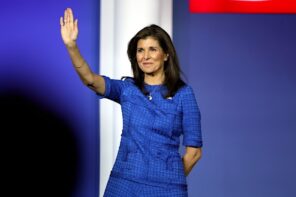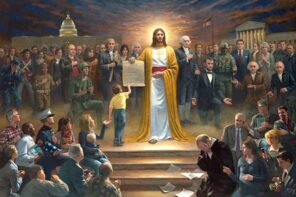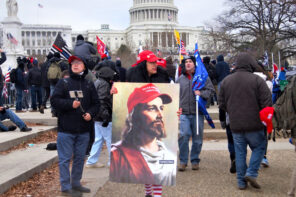Last week’s six-hour PBS documentary, God in America, wasn’t really about God in America. Nor was it about religions in America. Following a fairly conventional narrative in mainstream discourse (albeit not one adopted by the contemporary Christian Right), the series focused almost exclusively on the “intersections of religion and public life in America.”
The 3 two-hour episodes linger over Anne Hutchinson confronting John Winthrop over issues of freedom of conscience, Great Awakeners inadvertently but unmistakably preparing the way for the American Revolution, denominations splitting over slaveholders in their midst, Abraham Lincoln struggling to divine God’s purposes in America’s Great War, Darrow and Bryan dueling in the courtroom as proxies for a broader modernist-fundamentalist divide, Eisenhower presiding over a generic, 1950s American religion, Martin Luther King Jr. condemning America’s role as a “moral policeman,” and the religious right’s somewhat disillusioning experience with politics during the Reagan and second Bush presidencies.
A few other stories find their way in: the Spanish oppress the Puebloans; Jefferson cuts up the Bible, saving only the moral maxims; Rabbi Wise invents Reform Judaism; Muslims and other non-Christian groups arrive in large numbers. But this is primarily a story of how religion has interacted with some of the big events of American history.
American religious expression—its music and art, its stories of internal spiritual quests, its embodiment, its wild profusion of utopian groups, its history of ritual practices—will have to be found elsewhere.
Not that there’s anything wrong with that. God knows, while Glenn Beck rants in Twitter-like aphorisms condensing David Barton’s execrable version of history to a huge listening audience, and while Christian triumphalists fight to make their version of history the official one in textbooks, there’s plenty of room for reasoned, researched, and temperate documentaries. There’s a valuable public role for these kinds of series’ even if they only wind up preaching to the converted.
Furthermore, while the documentary necessarily leaves out a plethora of other stories, the show’s excellent accompanying Web site provides a wealth of material for further reading and discussion. The independent essay “The Black Church,” for example, is an outstanding model of compressed but sophisticated historical narrative, one that assuaged my uneasiness with the lack of a black presence up until the section on slavery and the Civil War.
Religious Freedom Fostered Religious Repression
The theme of the series is Exodus, liberty, and religious freedom; how, it asks, did we become a beacon of religious liberty and expression? Providing due time to both individual and social struggles for personal freedom of conscience, we meet the controversial Anne Hutchinson, who consumes a good chunk of the first hour; Frederick Douglass, who fulminates against the slaveholders’ religion during hour three; Charles Augustus Briggs, who sacrifices a comfortable academic career to endorse scientific findings in the fourth hour; civil rights leaders, who call us to the better angels of our nature in the fifth hour. The sixth and final hour touches on recent controversies over the so-called “Ground Zero Mosque” and lies about Obama’s religion, concluding with a warning: there’s plenty of work to do yet. Religious pluralism is a work in progress.
I’ve never produced a television series and will make no pretense of telling experienced documentarians how to do so. I liked God in America and will use portions of it in class for years to come. [Full disclosure: I was interviewed a few times by the show’s producers—once in person and several times by phone—and gave them some advice on what kinds of material I would like to see included.]
But I do want to ask what this series would look like if we also understand American religious history to be about coercion and authority? Most of God in America is about the white Protestant majority in American history. In a series on religion and public life, that is fair enough; they have dominated religion and public life. But what if we make coercion, establishment, and repression as central to our narrative as freedom, disestablishment, and expression? What if this is a show in which Americans’ self-understanding as derived from Exodus is more critically examined than celebrated?
To cite just one example: what would a show look like that made a serious effort to examine connections between the expansive religious democracy of antebellum camp meetings and the rise of slavery? In some respects, Anglo-Americans fostered an intense religious democracy built on a foundation of republicanism that assumed a close correlation between Protestantism and democracy. This world has been cogently described and celebrated in works such as Nathan Hatch’s The Democratization of American Christianity and Mark Noll’s America’s God. Yet, while white and black evangelicals helped to create and spread this nascent religious democracy, their religious ideas simultaneously sanctioned social hierarchies.
Our religious history is full of this intensely paradoxical interplay of religious freedom and equality with religiously-sanctioned unfreedom and inequality. That story is typically reduced to the fight against slavery—as it mostly is in this series—though it goes far beyond that. In this dialectic of religious freedom and unfreedom, embattled ethno-religious communities actually deployed the American tradition of religious liberty (as well as their own spiritual practices and sacred writings) to compel redefinitions of freedom, autonomy, and the rights of citizenship. The discourse of American freedom, then, could lead to very different ends than envisioned by the Anglo–Protestants who authored the classic texts on religious freedom.
In its third hour, God in America tells a story of how democratic politics and the rapid rise of populist Christian sects created a new context for American ideas of religio-political freedom. During the disruptions of the Revolutionary era, evangelical Christianity was at a relative low point. In 1780, few could have predicted the explosion of democratic Christianity that would so deeply imprint American culture by the 1830s, replacing Thomas Jefferson’s dream of a secular rationalist Republic with something more akin to a Methodist millennium.
A more critical examination might have also told the story, from the underside of that millennium, that while American ideas of freedom promised universalist visions they delivered a Republic that was, in practice, racially exclusivist and white supremacist. That was a tragedy, but it wasn’t an accident. The chosen nation myth, so frequently invoked in this show, was dependent on a false notion of innocence. The American Eden was a brutal one for its victims, including the nearly one million black Americans taken in the “Second Middle Passage” from the eastern seaboard to the Deep South during the very years that the Second Great Awakening proclaimed spiritual freedom for all.
Anglo-Americans created the evangelical synthesis. They also fostered a racially exclusivist and religiously restrictive culture that limited the freedom of those defined outside the ranks of the free and the citizen. This remained true during the era when America’s God was a republican and providentialist one. American religious history fundamentally has been about this dialectic of religious freedom in the dominant nation–state, the racialization of peoples, and the resulting struggle to forge spaces of freedom and autonomy, often through the creation or preservation of religious customs and institutions. Consequently, religious freedom, democracy, and republicanism fostered religiously-based repression.
Perhaps it is inevitable that a documentary reliant on a scholarly dominant narrative, and beholden by its very mission to speak to—and not alienate—a substantial viewing public, will tell a story that acknowledges some “dark sides” but ultimately is comforting and uplifting. Tired after a day’s work, we want Whig history. When done well, as is often the case here, it provides some heft to our treasured myths, film clips for our classrooms, and quick factual retorts to toss back at current-day purveyors of historical nonsense. That is all well and good, though I hope the show may ultimately be used not simply for a more sophisticated form of a myth of religious innocence, but to scrutinize the assumptions and elisions that lay behind that national story.




